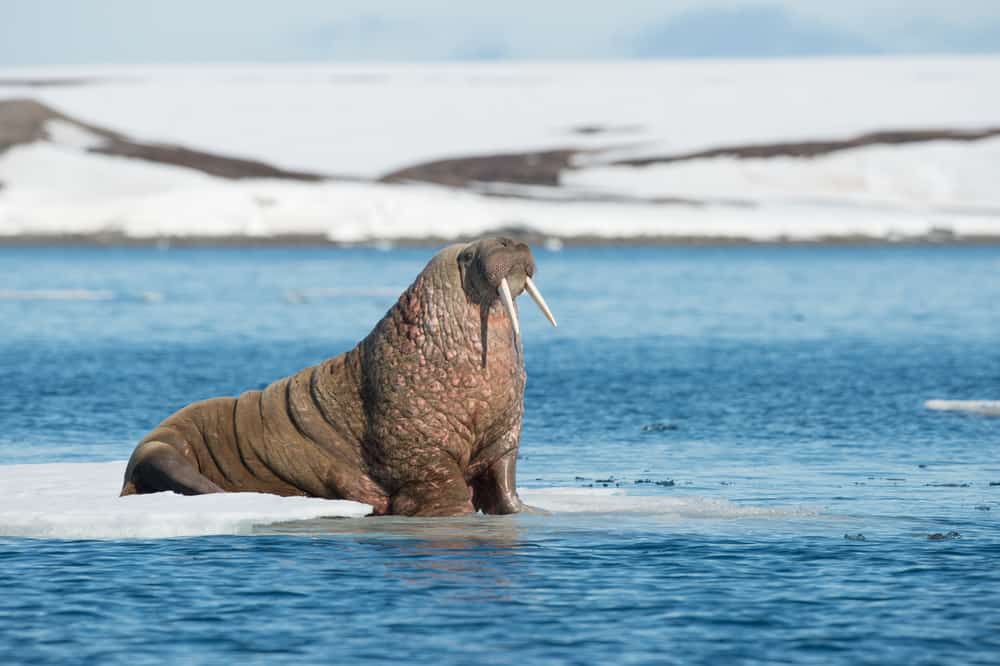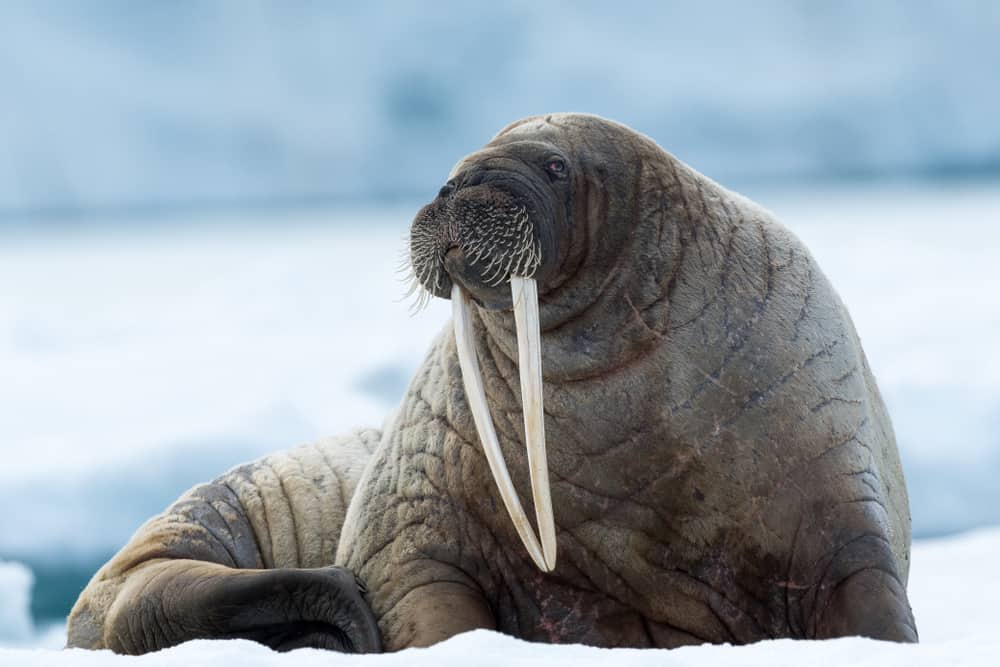The Family Odobenidae, commonly known as the walrus family, is a group of marine mammals that inhabit cold coastal waters in both hemispheres.
The two species within this family are the Pacific Walrus (Odobenus rosmarus divergens) and the Atlantic Walrus (Odobenus rosmarus rosmarus).
Walruses are well-known for their impressive tusks and blubbery bodies, but they are also fascinating creatures with unique adaptations to their environment.
Their prominent ivory tusks serve many purposes including defense, fighting for dominance, and aiding in hauling themselves out of water onto ice floes.
Additionally, their thick layers of fat insulate them from freezing temperatures, while their sensitive whiskers help them locate prey on the ocean floor.
Despite being hunted by humans for centuries for their valuable ivory and meat, these large and charismatic animals continue to thrive in some regions thanks to conservation efforts.
In this article we will delve deeper into the biology and behavior of these remarkable creatures.

Genus
Genus Odobenus – walrus
The Two Species Of The Odobenidae Family
The family Odobenidae, commonly known as walruses, comprises only two extant species: the Atlantic and Pacific walrus.
These marine mammals are easily distinguishable from other pinnipeds by their iconic long tusks protruding from their upper jaws. Both species possess a robust body shape with blubbery skin that protects them against cold water temperature.
Despite being closely related, Atlantic and Pacific walruses display some significant physical differences. The former is typically larger in size and weight than its counterpart, which can reach up to 3 meters in length and weigh around 2 tonnes.
Additionally, Atlantic walruses have longer tusks compared to those of Pacific walruses. Dietary preferences also vary between the two species; while both feed mainly on clams, mussels, and other benthic organisms found along the seabed, Atlantic walruses consume more molluscs than their counterparts do.
Understanding these distinctions is crucial for conservation efforts aimed at protecting each species’ specific habitat and ecological niche without interfering with their feeding patterns or mating cycles.
The Prominent Ivory Tusks Of Walruses
As previously mentioned, the Odobenidae family is composed of two species: the Pacific walrus (Odobenus rosmarus divergens) and the Atlantic walrus (Odobenus rosmarus rosmarus).
While these two species share many similarities in terms of their physical appearance and behavior, there are also some notable differences between them.
For instance, while both Pacific and Atlantic walruses have prominent ivory tusks, the former tend to be larger in size and more curved than those of the latter.
Ivory tusk growth in walruses is a fascinating area of study for marine mammal biologists.
These tusks can grow up to three feet long and weigh as much as 12 pounds each!
They are actually large canine teeth that protrude from the upper jaw of male and female walruses alike.
Scientists believe that these tusks serve several purposes, including defense against predators like polar bears and killer whales, breaking through sea ice during hunting expeditions, and even displaying dominance or attracting mates during mating season.
In addition to these functions, recent research has suggested that walruses may use their tusks for communication with one another – perhaps by tapping them on the ice or using them to make certain sounds underwater.
As such, further exploration into this topic will no doubt yield exciting new insights into how these remarkable animals interact with one another in their natural habitats.
The Thick Layers Of Fat That Insulate Walruses
The thick layers of fat, or blubber, that insulate walruses from the cold Arctic waters are a crucial adaptation for survival. This blubber layer can be up to 15 cm thick and serves as an effective thermal regulator, keeping the animal warm in frigid temperatures.
While other marine mammals have fur coats to keep them warm, the walrus relies solely on its blubber. The unique composition of walrus blubber allows it to not only store energy but also provide insulation.
The high concentration of unsaturated fatty acids in their blubber is what gives it this ability. These fatty acids remain fluid at low temperatures, allowing the blubber layer to maintain flexibility and effectively regulate heat loss through changes in thickness.
Additionally, blood vessels near the surface of the skin constrict when exposed to cold temperatures, reducing heat loss even further.
The Sensitive Whiskers Of Walruses
The sensitive whiskers of walruses have been a topic of interest and debate among marine mammal biologists for years. One theory suggests that these whiskers, also known as vibrissae, are used to detect prey in the murky waters where they hunt. However, recent studies have shown that their function may be more complex than originally thought.
Importance lies in understanding the adaptation of these unique sensory organs on walruses. The ability to sense vibrations and changes in water pressure allows them to navigate through dark and deep waters with ease, locate food sources, avoid predators, and communicate with other members of their species.
In addition, the development of technology inspired by the structure and function of these vibrissae has led to advancements in fields such as robotics and hydrodynamics. Understanding the importance of this adaptation not only sheds light on the behavior and ecology of walruses but also contributes to our knowledge in various scientific disciplines.

The History Of Human Hunting And Conservation Efforts
The sensitive whiskers of walruses play a crucial role in their survival. The sensory organs, called vibrissae, are used to detect prey, navigate through the water and communicate with other members of the species.
However, these delicate features also make walruses vulnerable to human impact. Over-harvesting for their ivory tusks and blubber during the 19th and early 20th centuries led to significant population declines across much of their range.
Despite conservation efforts since then, sustained hunting by indigenous communities and climate change continue to threaten walrus populations today. Currently listed as ‘vulnerable’ by the International Union for Conservation of Nature (IUCN), it is important that we prioritize research on this keystone Arctic species and work towards sustainable management practices to ensure its continued existence.
The Biology And Behavior Of Walruses
As the idiom goes, walruses are truly a jack of all trades and master of none when it comes to their biology and behavior. These flippered marine mammals have adapted to life in both water and on land, with large bodies that can weigh up to 2,000 kg.
Walruses possess two long tusks made from modified canine teeth which they use for defense, breaking through ice, or hoisting themselves out of the water.
Reproduction patterns among walruses vary depending on age and sex. Female walruses reach sexual maturity at around six years old, while males typically mature between seven and ten years old. Male walruses will compete for breeding rights with females during mating season. Once pregnant, female walruses carry their calves for approximately 15 months before giving birth on ice floes or rocky shores.
In terms of feeding habits, walruses primarily consume benthic invertebrates such as clams and mollusks by using their sensitive whiskers to locate prey on the ocean floor. They may also occasionally eat fish or other small aquatic animals found near the surface of the water.
Conclusion
The Odobenidae family, commonly known as walruses, is composed of two species: the Pacific and Atlantic walrus.
Walruses are renowned for their prominent ivory tusks that can grow up to one meter in length. These tusks serve various purposes such as defense against predators and navigation through ice sheets. Additionally, walruses have thick layers of fat called blubber which insulate them from cold environments.
Another distinctive feature of walruses are their sensitive whiskers or vibrissae used for detecting prey on ocean floors.
Despite being protected by conservation efforts today, humans historically hunted these magnificent creatures extensively for their valuable ivory tusks and meat.
The biology and behavior of walruses continue to fascinate marine mammal biologists.
In conclusion, the fascinating attributes of the Odobenidae family make it a significant subject in marine biology research.
Referred to in literature as “the great sea elephant” due to its massive size, the walrus has been featured in numerous cultural works throughout history. From Moby Dick to Arctic Dreams, this intriguing creature continues to captivate audiences with its unique physical features and remarkable behaviors.
As we learn more about this amazing animal, let us strive towards sustainable practices that will ensure its survival for generations to come.

